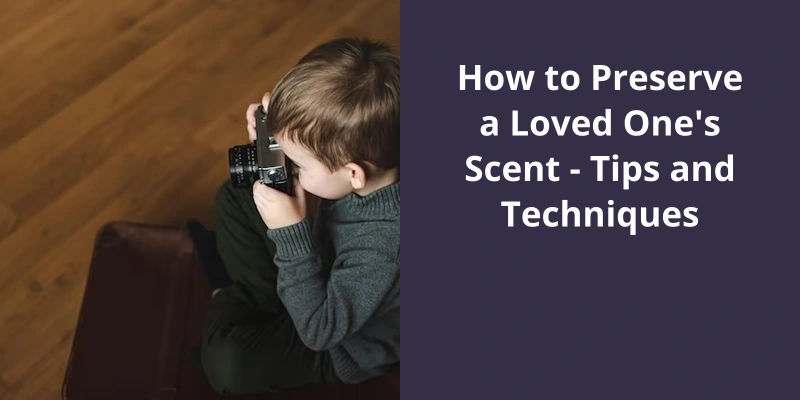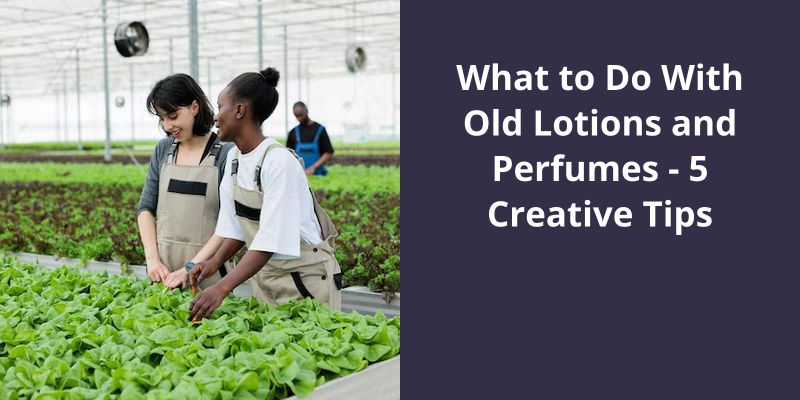Preserving a loved one’s scent can be achieved in several ways. First, refrain from washing items that carry the person’s scent like clothes or bed linens and store them in a sealed plastic bag to hold in the smell. Wear their used clothing items sparingly to keep the smell from fading. Also, consider creating a scent capsule by sealing small fabric items that have absorbed the person’s scent in a mason jar. Fragrance sprays can also be made by mixing the person’s favorite perfume or essential oil with water. To make it lasting, add a preservation medium like perfumer’s alcohol. Sadly, scents do fade over time, but these methods can help you preserve it for a while.

Can You Preserve the Smell of a Person?
However, this method may not be the best solution for preserving the scent of a person, as the plastic can alter or even completely remove the smell over time. This is because plastic bags aren’t breathable, which can trap moisture and sweat, leading to mold and mildew growth, which can cause unpleasant odors.
An alternative method to preserve the scent of a person is to use a non-plastic, breathable container, such as a cotton or linen bag. This will allow the scent to remain intact without any interference from moisture. Additionally, items such as lavender or rose petals can be added to enhance the scent and keep it fresher for longer. Alternatively, you could opt for a wooden box, which can help to absorb moisture and keep the scent intact for longer periods of time.
These items will absorb the scent and keep it in for longer periods of time, while also providing a comforting reminder of the person. However, it’s important to note that these items may need to be replaced or refilled after a while, as the scent may fade over time.
If you’re looking to preserve the scent of a person on their clothing, it’s best to store the clothing in a safe, dry place, such as a wardrobe or closet. It’s also important to separate these items from other clothing and fabrics, so that the scent isn’t contaminated by other smells. Additionally, adding a scented sachet or dryer sheet to the storage area can also help to keep the scent fresh for longer periods of time.
How Scent Can Trigger Memories and Emotions
The sense of smell is closely tied to memory and emotions. When we smell a particular scent, it can bring back memories and evoke certain emotions associated with those memories. This is because the olfactory nerve, responsible for our sense of smell, is connected to the limbic system in our brain, which processes emotions and memories. Thus, scent can be a powerful tool in triggering nostalgia and emotional responses.
As societies continue to embrace the importance of preserving their history and culture, new frontiers are being explored. One of these is scent preservation – a practice that seeks to conserve scents as part of our heritage. With academic and practical research being conducted, this field is gaining momentum as experts explore the identification, analysis, and archiving of scents. But is it truly possible to preserve a smell? Let’s delve deeper and find out.
Is It Possible to Preserve a Smell?
The question of whether it’s possible to preserve a smell is a complex one. On the one hand, scents are notoriously ephemeral, often fading quickly and leaving little behind. However, there are many examples of smells that have been successfully preserved over time, from historic perfumes to preserved herbs and spices. The key to scent preservation is careful identification and analysis of the scent in question, as well as an understanding of the best techniques for archiving it.
One of the main challenges of scent preservation is that smells are highly subjective and can be difficult to describe. However, researchers have developed a range of techniques for identifying and analyzing smells, including gas chromatography-mass spectrometry (GC-MS), which can break down a scent into it’s individual chemical components.
For example, the Osmotheque in Versailles, France, is a renowned fragrance archive that aims to preserve the rich history of perfume making. The archive holds thousands of historic fragrances and has been instrumental in reviving lost scents from throughout history.
The Science Behind Memory and Scent Association
Memory and scent association occur due to the activation of the limbic system, which is responsible for emotions and memories. The olfactory bulb, located in the limbic system, receives signals from scent molecules and sends them to the brain, where they’re associated with emotions and memories. This association is strengthened through repeated exposure to the same scent, leading to a powerful and long-lasting memory recall triggered by the same scent.
Source: My husband died 5 days ago. How can I preserve his smell …
Innovations in technology have led to the creation of devices that allow us to capture the essence of our world in ways we never thought possible. One such device is the smell capture system, which promises to capture the essence of any scent in a matter of minutes. But how does it work, and is it really possible to capture a smell? Let’s explore this fascinating area of research.
Is It Possible to Capture a Smell?
The idea of capturing a smell has intrigued scientists and researchers for years. It’s a complex process that involves a thorough understanding of how the human nose works and how different chemicals interact to create a scent. While we can detect and identify thousands of different scents, capturing them in their pure form has been a challenge. However, recent developments in technology have made it possible to capture and store smells for a variety of purposes.
One of the main applications of capturing smells is in the perfume industry. Perfumers are constantly looking for new scents to incorporate into their products, and capturing the essence of a particular flower or fruit can be a crucial step in the process. By using special equipment and techniques, perfume makers can extract and reproduce the scent of almost anything, from roses to lemons to freshly baked bread.
Another use for scent capture technology is in medical research. Researchers have found that certain odours can have a profound effect on the human brain, triggering emotions and even altering our mood and behaviour. By capturing and studying these scents, scientists can gain a better understanding of how our sense of smell works, and potentially develop new treatments for conditions like depression and anxiety.
One of the most exciting developments in scent technology is the creation of digital scent devices. These gadgets use complex algorithms and hardware to mimic the way our nose works, creating a range of smells that can be experienced in virtual reality environments. While still in the early stages of development, these devices have the potential to revolutionize industries like gaming, advertising, and even education.
Despite these advances, capturing a smell isn’t an easy task. Even with the best equipment and techniques, it can take hours or even days to extract a pure scent, and the process is often expensive and time-consuming.
The History of Scent Capture Technology and It’s Evolution Over Time
Scent capture technology has undergone significant changes over the years, from ancient methods of using plants to modern methods that utilize cutting-edge technology. Throughout history, individuals and groups have explored various techniques for capturing scents from their surroundings. Today, scent capture technology is used in a variety of industries, including perfume, food and beverage, and medicine. It’s evolution has been marked by a combination of scientific progress and an increased understanding of the essential role that scent plays in everyday life.
Understanding the science behind smells can lead to some interesting discoveries, like capturing them in a jar. By heating certain substances, it’s possible to collect vaporized scent molecules in a jar. These molecules, a result of atoms bonding together, are the building blocks of all smells.
Can You Capture a Smell in a Jar?
These molecules make up the complex scents that we smell in our everyday lives. Some of these molecules are volatile, meaning that they evaporate easily and become airborne. By heating a substance that contains volatile molecules, such as a flower or a citrus fruit, you can capture a portion of those molecules in a jar and preserve the scent for future use.
It’s important to note that not all scents can be captured in a jar in this way. Some scents are too volatile and will simply dissipate before you’ve a chance to trap them. Others may not contain enough volatile molecules to make it worth the effort.
One popular method for capturing scents in a jar is to create a homemade “potpourri” mixture. This can be done by combining dried flowers, herbs, and other fragrant materials in a bowl or container and placing it on a warm surface. As the mixture heats up, volatile molecules are released into the air and can be captured in a nearby jar. This can be a great way to preserve the scent of a favorite flower or herb that’s out of season or not readily available.
This involves heating a mixture of water and fragrant materials in a container, and allowing the steam that forms to pass through a tube and into a separate container. As the steam cools, it condenses back into a liquid and collects in the container, trapping some of the volatile scent molecules along the way. This method is often used in the production of essential oils, which can be used in a variety of applications, from aromatherapy to cooking.
The Science of Olfactory Perception and How Our Sense of Smell Works
Olfactory perception refers to our sense of smell and how it works. It involves the detection and processing of odor molecules by specialized cells in our nose. The information is then sent to our brain, where it’s interpreted and identified as a specific smell. Despite being a complex process, our sense of smell is incredibly powerful and can evoke strong emotional memories and reactions.
Now that we’ve an understanding of why certain smells linger, we can delve into the different types of odors and their varying degrees of persistence.
What Makes a Smell Linger?
However, some of the more persistent smells gas molecules can move through surfaces to become trapped in interesting areas. For example, inside the porous materials and between fibers in a carpet, the tiny gas molecules can become trapped. The amount of time the scent remains can also rely on environmental factors, like humidity levels, which can slow down or speed up the decomposition of the molecules.
Sweat is also one of the bodys natural odors that can linger. A persons diet, metabolism, and stress levels can impact how they smell. For some, the residue left behind on clothing can be a source of embarrassment, and while it’s always important to practice good hygiene, knowing whats behind the lingering scent can help one address it better.
The chemical composition of scent also plays a big role in whether or not a smell lingers. Certain compounds are more stable and robust, particularly ones that are highly polar, making it easier for dissimilar molecules to mix. In contrast, non-polar compounds dissolve much less well in water, and can be less likely to remain after they’ve been released.
Certain factors, like air circulation, can also impact how far a scent travels and how long it lasts. Lack of ventilation can cause smells to stay longer, particularly if they’ve been absorbed into clothing or other absorbent surfaces. In contrast, adequate air circulation helps to move molecules out of enclosed areas and decrease the amount of time a smell remains.
Finally, the level of concentration of an odor can also impact how long it lasts. High concentration scents can take more time to dissipate and are more likely to linger after the initial exposure. In contrast, low concentration odors tend to evaporate and disperse more quickly, making them less likely to stick around. Overall, there are many factors that determine how long a smell lasts, from the chemical composition of the scent to environmental conditions like air circulation, levels of humidity, and surrounding surfaces surfaces. Understanding these factors can help individuals address unwanted lingering smells more effectively.
How Different Surfaces (Such as Fabrics, Walls, and Furniture) Can Trap and Hold Onto Smells
Different surfaces can absorb and retain odors from various sources such as food, smoke, and pets. Porous surfaces like fabrics and carpets tend to trap smells more easily than non-porous ones like walls and furniture. Airborne particles such as smoke and cooking fumes can penetrate into the fibers of the material and get trapped there. Additionally, chemicals and bacteria from sweat, body oils, and pet fur can also lead to persistent odors. Using a combination of cleaning, odor eliminators, and good ventilation can help to mitigate these smells.
The complex nature of smell has always baffled scientists and researchers, as it can’t be digitised as easily as sound or light. Unlike light and sound, our ability to perceive odour is a result of organic components found in actual molecules that produce different smells. However, recent advancements in technology have led to the possibility of digitally capturing smells.
Why Can’t We Capture Smell?
However, odour is a complex combination of molecules that are constantly changing in the environment. Our noses are capable of distinguishing thousands of different smells, each with their own unique combination of molecules. These molecules are constantly interacting with one another, creating new combinations that we can smell. The sheer number of possible combinations makes it extremely difficult to accurately capture and replicate a smell digitally.
Furthermore, our sense of smell is closely tied to our memories and emotions. While we can describe a smell using words, it’s impossible to truly convey the full experience of that smell without actually experiencing it firsthand.
Additionally, our sense of smell is affected by a number of environmental factors, including temperature, humidity, and air flow. Even if we could capture a smell in a controlled environment, it may not accurately represent how that smell would be perceived in the real world.
Finally, our olfactory system is incredibly complex and not fully understood. While we know that certain molecules are responsible for specific smells, there’s still much we don’t know about how our brain processes and interprets these signals.
How Can Smells Affect Our Mood and Behavior?
Our sense of smell is closely linked to the limbic system, which is the part of our brain that controls emotions and memories. Therefore, certain smells can trigger certain emotions and behaviors in individuals, such as making them feel happy or anxious.
Conclusion
In conclusion, preserving the smell of a loved one is something that holds a significant emotional value for many people. While there may not be any proven techniques to preserve smells perfectly, keeping their belongings sealed in an airtight container can certainly prolong the life of the scent. As with all things, time will eventually take it’s toll and the smell will begin to dissipate. However, with careful handling and storage, you can enjoy the smell of your loved one for as long as possible. Remember, the scent may fade, but the memories and emotions associated with it will always remain with you.





